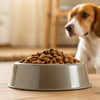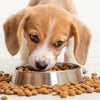Should I Feed My Dog Wet Food or Dry? A Comprehensive Guide for Pet Owners
- Houndsy
Table of Contents
- Introduction
- Understanding Wet and Dry Dog Food
- Benefits of Wet Dog Food
- Benefits of Dry Dog Food
- The Great Debate: Wet vs. Dry
- Our Commitment to Elevating Pet Care
- Conclusion
Introduction
Did you know that nearly 60% of dog owners grapple with the question of whether to feed their furry friends wet food or dry kibble? It's a common conundrum that can leave us questioning not only what's best for our pet's health but also their happiness. The world of dog food is vast and often overwhelming, with countless brands, ingredients, and feeding options available. As responsible pet owners, we want to ensure that our beloved companions receive the best nutrition possible while also enjoying their meals.
In this blog post, we will delve into the ongoing debate of "should I feed my dog wet food or dry?" By the end, you’ll have a comprehensive understanding of the nutritional benefits, drawbacks, and unique features of both feeding options. We'll also explore how we can simplify and elevate this everyday ritual, making it a joyful experience for both us and our pets. Let’s embark on this journey together as we aim to enhance our dog feeding routines.
Understanding Wet and Dry Dog Food
What is Wet Dog Food?
Wet dog food, often found in cans or pouches, is typically made from protein sources like meat, grains, and vegetables. The processing of wet food involves grinding these ingredients and then cooking them with added moisture, resulting in a product with a moisture content of about 75-78%. This high moisture content makes it particularly appealing for dogs that may not drink enough water or those with specific health concerns.
What is Dry Dog Food?
Dry dog food, commonly referred to as kibble, is made from similar ingredients but undergoes a different manufacturing process. The meat and other components are mixed, cooked, and then extruded into shapes before being dehydrated, resulting in a much lower moisture content—around 10%. This makes dry kibble easier to store, portion, and feed, but it lacks the hydration benefits of wet food.
Nutritional Comparisons
Both wet and dry dog food can provide balanced nutrition, but they offer different benefits that may align with your dog's specific needs.
- Moisture Content: Wet food is excellent for hydration, which is crucial for dogs with urinary issues or those that are less inclined to drink water.
- Palatability: Many dogs find wet food more enticing due to its aroma and texture, making it a great option for picky eaters or dogs recovering from illness.
- Dental Health: Dry kibble can help clean teeth as dogs chew, reducing tartar buildup and promoting better oral health.
Understanding these differences can help us make more informed decisions about our dog's dietary needs.
Benefits of Wet Dog Food
1. Higher Moisture Content
As previously mentioned, wet dog food contains significantly more moisture than kibble. This can be beneficial for dogs who struggle to drink enough water, helping to prevent dehydration and urinary tract issues. For dogs with kidney disease or other health problems that require increased fluid intake, wet food can be a lifesaver.
2. Increased Palatability
The rich aroma and texture of wet food often entice even the fussiest eaters. If you have a dog that turns their nose up at kibble, incorporating wet food can make mealtime more enjoyable and encourage them to eat consistently.
3. Enhanced Satiety
Dogs tend to feel fuller after consuming wet food, which can aid in weight management. This is particularly useful for dogs that seem to always be hungry or for those on a weight-loss regimen.
4. Easier to Chew
For senior dogs or those with dental issues, wet food can be easier to chew and digest. The softer texture allows them to enjoy their meals without discomfort.
Benefits of Dry Dog Food
1. Dental Health Benefits
One of the significant advantages of dry kibble is its potential to support dental health. The crunchiness of kibble encourages dogs to chew, helping to scrape off plaque and reduce tartar buildup, thus promoting better oral hygiene.
2. Convenience and Portability
Dry dog food is incredibly convenient. It can be stored easily, is less messy, and can be left out for longer periods without spoiling. This is particularly beneficial for dogs that prefer to graze throughout the day.
3. Cost-Effectiveness
Generally, dry dog food is more affordable than wet food. The longer shelf-life and bulk packaging options make it an economically viable choice for many pet owners.
4. Food Enrichment Options
Kibble can be easily incorporated into food puzzles and slow feeders, providing mental stimulation and enhancing your dog’s feeding experience. This is especially important for active dogs that require both physical and mental engagement.
The Great Debate: Wet vs. Dry
Factors to Consider
When pondering the question, "should I feed my dog wet food or dry?", several factors should guide your decision:
- Health Needs: Consider your dog's specific health conditions. For instance, senior dogs or those with dental issues may benefit more from wet food, while active dogs may thrive on dry kibble.
- Personal Preference: Just like us, dogs can have preferences. If your dog seems to favor one type over the other, that may influence your choice.
- Cost and Storage: Evaluate your budget and storage capabilities. Dry food generally offers more convenience and lower costs, but wet food provides additional hydration benefits.
- Feeding Routine: Reflect on your daily routine and how each type of food fits into it. If you’re often busy, dry food may offer a simpler solution for feeding.
Mixing Wet and Dry Food
One popular option among dog owners is to mix wet and dry food. This approach allows us to take advantage of the benefits of both types while providing variety in our dog's diet. However, it’s crucial to monitor portion sizes to avoid overfeeding and to ensure that the mixed diet meets your dog’s nutritional requirements.
Our Commitment to Elevating Pet Care
At Houndsy, we understand the importance of simplifying and enhancing the everyday experiences of pet owners. Our flagship product, the Houndsy Kibble Dispenser, is designed with convenience and aesthetic appeal in mind. With perfect portion control and an ergonomic crank at standing height, we make feeding time easier and more enjoyable for both you and your pet.
Imagine effortlessly dispensing your dog's dry kibble while also being inspired by the sleek, mid-century modern design that complements your home decor. Our dispenser not only serves the practical purpose of feeding but elevates the entire ritual into a more enjoyable experience.
Learn more about how the Houndsy Kibble Dispenser can transform your dog's feeding routine today!
Conclusion
Deciding whether to feed your dog wet food or dry food ultimately depends on your pet's individual needs, preferences, and your lifestyle as a pet owner. Both options have their unique benefits and drawbacks, making it essential to consider factors such as health, convenience, and cost when making your decision.
Whether you choose wet food, dry kibble, or a combination of both, the most important aspect is ensuring that your dog receives balanced nutrition and enjoys their meals. By understanding the differences and embracing innovative solutions like the Houndsy Kibble Dispenser, we can elevate our pet care routines and enhance our furry friends' lives.
FAQ
1. Can I mix wet and dry dog food?
Yes, mixing wet and dry dog food is a common practice among pet owners. It allows you to provide variety and take advantage of the unique benefits each type offers.
2. How do I determine the right portion sizes?
Consult your veterinarian for guidance on your dog's specific caloric needs. They can help you calculate the appropriate portion sizes for each type of food.
3. Is wet food more expensive than dry food?
Generally, yes. Wet food tends to be more costly per serving compared to dry kibble, but it can provide added hydration benefits.
4. Can I store wet food after opening?
Once opened, wet food should be refrigerated and consumed within a few days to ensure freshness and prevent spoilage.
5. How do I transition my dog to a new food?
When transitioning your dog to a new food, do it gradually over a week or so. Mix a small amount of the new food with the old food, gradually increasing the new food while decreasing the old food to avoid digestive upset.
By understanding the nuances of wet and dry dog food, we can confidently provide our pets with the best nutrition tailored to their needs. Let’s embrace the joy of feeding our dogs and the bond it strengthens in our everyday lives!












